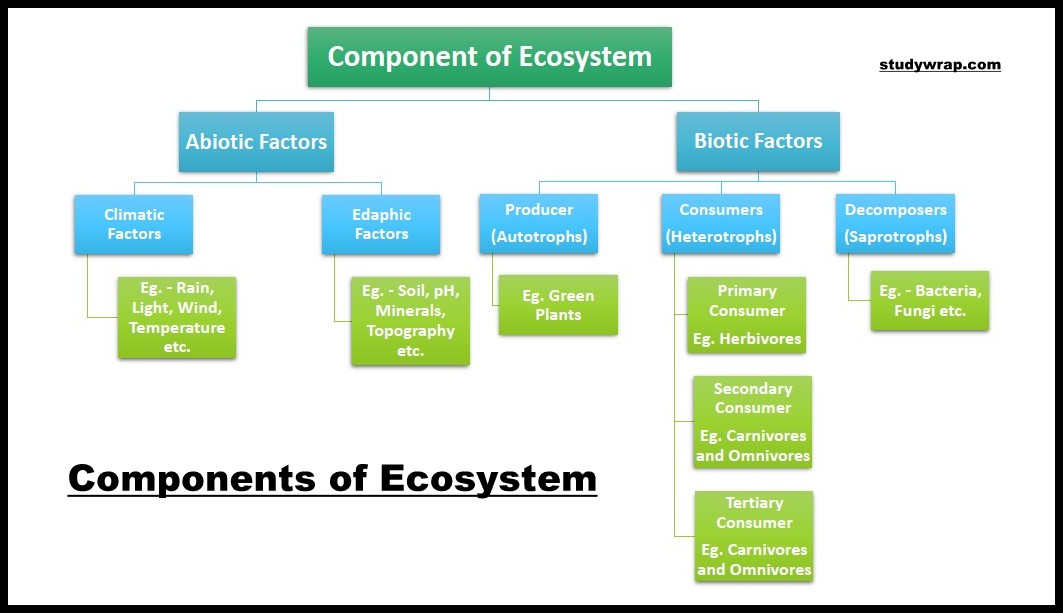Environment
Levels of Organisation in Ecology – Individual to Biosphere
ECOLOGY
Table of Contents
- The term ecology is derived from the Greek word ‘oikos’ meaning ‘house’, combined with the word ‘logy’ meaning the ‘science of’ or ‘the study of’. Literally it is the study of the home of nature.
- The word was first used by Ernst Haeckel in 1869.
- In 1969, Odum defined ecology as ‘the study of structure and function of nature’.
- The scientific study of the interactions between organisms and their environment and with each other is known as ecology.
- It deals with the ways in which organisms are moulded by their environment, how they make use of environmental resources including energy flow and mineral cycling.
LEVELS OF ORGANISATION IN ECOLOGY
The main Levels of Organisation in Ecology are as follows –
-
-
-
-
-
- Individual
- Population
- Community
- Ecosystem
- Biome
- Biosphere
-
-
-
-
1. Individual and Species
-
-
- Organism is an individual living being that has the ability to act or function independently.
- Species are a group of living organisms consisting of similar individuals capable of exchanging genes or of interbreeding.
- They are considered as the basic unit of taxonomy and could be be plant, animal, bacterium, fungi, etc.
-
2. Population
-
-
- Population is a community of interbreeding organisms (same species), occupying a defined area during a specific time.
- Population growth rate can be positive due to birth and/or immigration or negative due to death and/or emigration.
- The main factors that make population increase are birth and immigration.
- The main factors that make population decrease are death and emigration.
-
3. Community
-
-
- A community may have one or several species.
- Communities in most instances are named after the dominant plant form.
- In order to survive, individuals of any one species depend on individuals of different species with which they actively interact in several ways.
- For example, a grassland community is dominated by grasses, though it may contain herbs, trees, etc.
- The environmental factors determine the characteristic of the community as well as the pattern of organisation of the members in the community.
-
Types of Community
On the basis of size and degree of relative independence communities may be divided into two types –
Major Communities
-
-
-
-
- These are large sized and relatively independent.
- They depend only on the sun’s energy from outside. E.g. Tropical evergreen forests.
-
-
-
Minor Communities
-
-
-
-
- These are dependent on neighbouring communities and are often called societies.
- They are secondary aggregations within a major community and are not completely independent units for energy and nutrient requirement. E.g. A mat of lichen on a cow dung pad.
-
-
-
4. Ecosystem
-
-
- An ecosystem is defined as a structural and functional unit of biosphere consisting of community of living beings and the physical environment, both interacting and exchanging materials between them.
- It includes plants, trees, animals, fish, birds, micro-organisms, water, soil, and people.
- When an ecosystem is sustainable it means that all the elements live in balance and are capable of reproducing themselves. It can be as small as a single tree or as large as entire forest.
-
Components of Ecosystem
-
-
-
-
- The components of ecosystem and environment are same i.e. Biotic and Abiotic.
-
-
-
5. Biome
-
-
- A biome is a large naturally occurring community of flora and fauna occupying a major habitat. E.g. Rainforest biome or tundra biome.
- Plants and animals in a biome have common characteristics due to similar climates and can be found over a range of continents.
- No two biomes are alike. The climate determines the boundaries of a biome and abundance of plants and animals found in each one of them. The most important climatic factors are temperature and precipitation.
- Biomes are distinct from habitats because any biome can comprise a variety of habitats.
-
6. Biosphere
-
-
- The biosphere includes all living organisms on earth, together with the dead organic matter produced by them.
- Biosphere is a part of the earth where life can exist.
- Biosphere is that part of lithosphere, hydrosphere and atmosphere where plants and human beings live. It contains all life forms on earth.
- The biosphere consists of all the living organisms (the biotic component), energy and physical environment (the abiotic component) and there are continuous interactions between living organisms and physical environment and among the living organisms themselves.
-
-
-
- The biosphere consists of two major systems, namely –
-
- Terrestrial Biomes Systems – It is further comprised of three subsystems i.e. plant system, animal system and soil system.
- Aquatic Biomes Systems – It is also composed of three sub-systems i.e. Plant system, Animal system, and Nutrients.
-
- These subsystems are closely interconnected among themselves through the cyclic pathways of movements and transfer of energy and materials.
- Man depends on biosphere to fulfill many of his needs like food, drugs, clothes, housing, paper and tourism and environment.
- Biosphere is absent at extremes of the North and South poles, the highest mountains and the deepest oceans, since existing hostile conditions there do not support life.
- The biosphere consists of two major systems, namely –
-
So, this was all about Ecology and Levels of Organisation in Ecology.
In the Next Post (Click Here), We will discuss about the Principles of Ecology and Its Fundamental Concepts.




